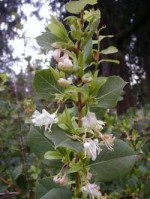 If you looked at the botanic name for winter honeysuckle you probably noticed a word you partially recognized, “fragrantissima”. If you take off the suffix –issima, the name tells you that this plant is fragrant; add the “–issima”, that means “very” in Latin, and you have “very fragrant”, one of the outstanding characteristics of this plant. The tubular white flowers that produce this wonderful lemony scent dangle on leafless stems in winter to spring and are equally pleasant in the garden or as part of a winter bouquet. The flowers are followed by small red berries and bluish green foliage that persists well into autumn, longer than the foliage of most other shrubs. Winter honeysuckle makes a nice backdrop for annuals and perennials in the border and can also be used as a hedge or screen.
If you looked at the botanic name for winter honeysuckle you probably noticed a word you partially recognized, “fragrantissima”. If you take off the suffix –issima, the name tells you that this plant is fragrant; add the “–issima”, that means “very” in Latin, and you have “very fragrant”, one of the outstanding characteristics of this plant. The tubular white flowers that produce this wonderful lemony scent dangle on leafless stems in winter to spring and are equally pleasant in the garden or as part of a winter bouquet. The flowers are followed by small red berries and bluish green foliage that persists well into autumn, longer than the foliage of most other shrubs. Winter honeysuckle makes a nice backdrop for annuals and perennials in the border and can also be used as a hedge or screen.
Type: Deciduous shrub in zones 4-5; maybe semi-deciduous in warmer areas.
Outstanding Feature: Scented, creamy white flowers in late winter to early spring.
Form: Twiggy growth results in an irregular mound.
Growth Rate: Rapid.
Bloom: Lemon scented, creamy white flowers tinged with pink or red in late winter to early spring.
Size: 6-10’ H x 6-8’ W.
Light: Sun to partial shade.
Soil: Moist, well drained loam; but tolerates less.
Hardiness: Zones 4-8.
Care: Prune after flowering to control shape and/or size; can be cut back hard.
Pests and Diseases: No serious pests or diseases but susceptible to damage by leaf spot, blight powdery mildew, aphids, scale, sawfly, whitefly, loopers, plant hoppers, flea beetles and webworm.
Propagation: Division of clumps; cuttings root easily in water.

My grandmother and aunts, back in Alabama, called this plant “kiss-me-at-the-gate.” Nice, huh?
Carol,
Sounds like a perfect name for a great plant.
Karen